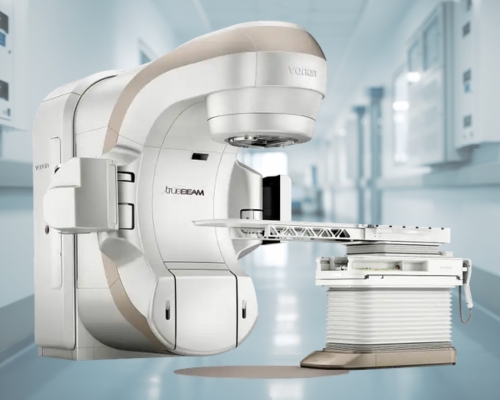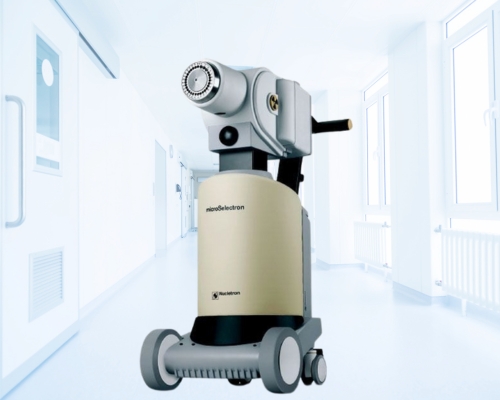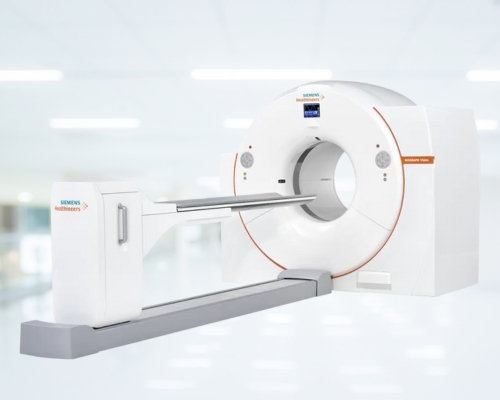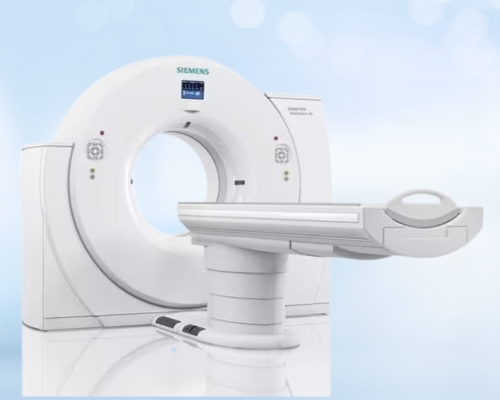Varian TrueBeam Linear Accelerators (LINAC)

The Linear Accelerator, known as LINAC, is the most widely used equipment for delivering external beam radiation therapy to cancer patients. It produces high-energy X-rays that are precisely aimed at the tumor site, targeting and destroying cancer cells while sparing the healthy tissues surrounding the tumor. This technology is a remarkable advancement in cancer treatment, offering a non-invasive and painless approach. Linear Accelerators have significantly benefited patients, providing effective care with minimal discomfort. The technology is further enhanced by IGRT and IMRT techniques. IGRT, or Image-Guided Radiation Therapy, combines imaging with radiation to enhance the accuracy and precision of the treatment. At the same time, IMRT, or Intensity-Modulated Radiation Therapy, utilizes advanced software and hardware to adjust the radiation’s intensity and shape according to the specific needs of different areas within the treatment zone.
How Does It Help?
Linear Accelerators are commonly employed in external beam radiation therapy for cancer patients. They are capable of treating cancerous cells in any part or organ of the body. The advent of Linear Accelerator technology has been a tremendous breakthrough for those battling cancer, offering a treatment option that does not require surgery.
How Is It Done?
Preparation
Getting Ready for Radiation Therapy
- The preparation for radiation therapy begins with a process called simulation. The patient will be asked to change into a gown provided by Sharda Care - Healthcity and lie still on the treatment table.
- During simulation, detailed scans and imaging are performed to pinpoint the location of the tumor and the surrounding healthy tissues. The patient must maintain the exact same position during both the simulation and actual treatment to ensure accuracy.
- Body markings, head masks, and even small tattoos are often used to help achieve precise positioning. Once the simulation is complete, the oncologist at Sharda Care - Healthcity determines the specific area to be targeted, the radiation dose, the exposure for normal tissues, and the angle of radiation delivery.
Treatment
During Radiation Therapy
- Following the simulation, a treatment plan is created based on the gathered data. The therapy is divided into multiple sessions, delivering small doses of radiation daily over several weeks, with the treatment course typically lasting from one to seven weeks.
- During each session, the patient lies on a table that moves in various directions. The Linear Accelerator then directs X-rays precisely at the targeted area. The radiographer operates the machine from a separate room, and the patient can communicate through an intercom system.
- The procedure requires the patient to stay as still as possible, and it only takes a few minutes each day. The process is completely painless. Throughout the first week and in the following sessions, the medical team and oncologist closely monitor the therapy to ensure it aligns perfectly with the treatment plan.
Post Treatment
After Radiation Therapy
- Throughout the treatment period, the patient’s schedule, dosage, and overall health are closely monitored. Imaging tests are conducted periodically to assess the effectiveness of the therapy.
- If the patient experiences any allergic reactions to radiation or notices any side effects—though these are rare—it is important to inform the doctor or oncologist immediately.
What Are the Advantages and Risks of Linear Accelerator Technology?
- Enhanced Precision with IGRT: Image-Guided Radiation Therapy (IGRT) uses advanced imaging techniques before and during treatment sessions to ensure precise radiation delivery. This minimizes harm to surrounding healthy tissues and reduces treatment toxicity.
- Targeted Radiation with IMRT: Intensity-Modulated Radiation Therapy (IMRT) utilizes 3-D CT scans and computerized calculations to deliver highly targeted radiation. This accuracy can effectively shrink tumors before surgery and improve overall treatment efficacy.
- Combination with Chemotherapy: Radiation therapy, when combined with chemotherapy, enhances treatment outcomes, increasing the chances of eradicating cancer.
- Post-Surgery Effectiveness: Radiation therapy can target residual cancer cells after surgery, reducing the risk of recurrence.
- Outpatient Convenience: Sessions are typically 15 to 30 minutes long and performed on an outpatient basis, allowing patients to continue their daily activities without requiring hospitalization.
Risks of Linear Accelerator Technology
- Potential Side Effects: Although advanced techniques minimize damage to healthy tissues, patients may still experience side effects like fatigue, skin irritation, or localized swelling.
- Tissue Sensitivity: Even with targeted radiation, sensitive tissues near the treatment site may be affected, which can lead to long-term complications in some cases.
- Cumulative Toxicity: For patients undergoing combined chemotherapy and radiation, the overall treatment toxicity may increase, requiring careful management.
- Residual Damage Risk: Despite its precision, there remains a small risk of radiation impacting unintended areas, particularly in complex tumor sites.
What Sets Linear Accelerators Apart?
- Linear accelerators produce X-rays that destroy the DNA of cancer cells, which is the molecule responsible for passing genetic information from one generation to the next. Once this DNA is damaged, cancer cells lose their ability to divide and ultimately die.
- While radiation therapy can also affect healthy cells, it is often combined with techniques like IGRT (Image-Guided Radiation Therapy) and IMRT (Intensity-Modulated Radiation Therapy) to enhance the accuracy and effectiveness of targeting cancer cells.
- Sharda Care - Healthcity utilizes advanced technologies like Elekta Infinity and Elekta Synergy, which blend precision, speed, and control. This technology also allows for personalized treatment and imaging workflows, tailored to individual patient needs. It offers proven reliability, performance, and safety as a seventh-generation integrated digital control system.
Looking for an Expert
Sharda Care - Healthcity is home to some of the eminent Doctors in the world.
Book an Appointment








